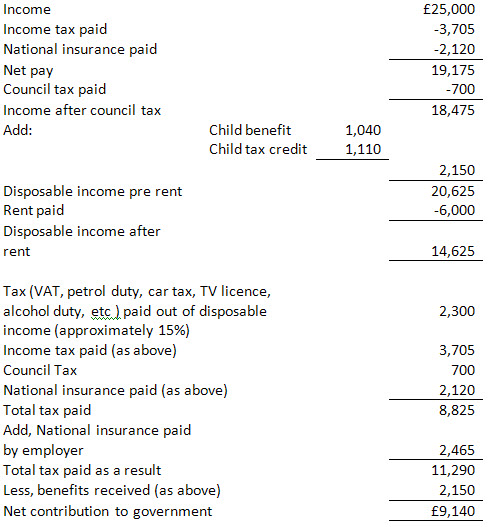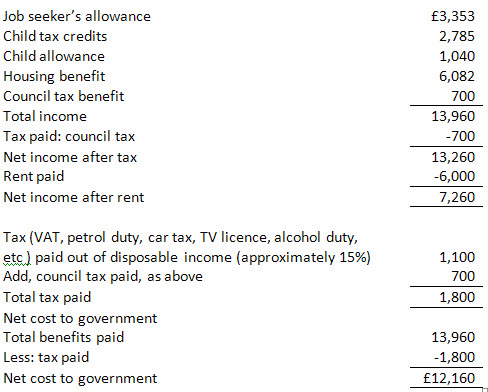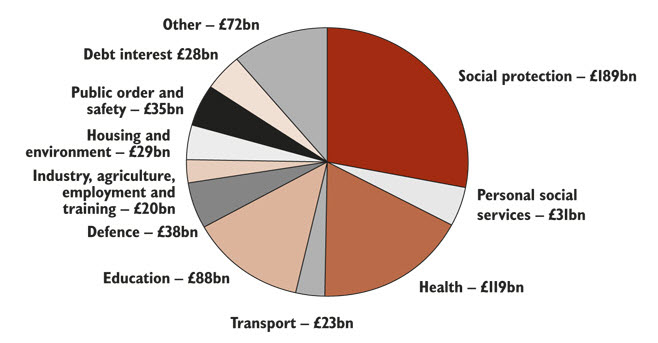I wrote the following blog in June 2009. Now we have a government proposing to slash public sector employment it seems worth repeating it. The logic has not changed, at all.
“Give or take the public sector employs about 5 million people. If, as is demanded, there should be public sector cuts of at least 10% then maybe 500,000 people will lose their jobs.
I have considered the consequence of this by doing a simple exercise. I have done a case study on the cost of a person earning £25,000 per annum who is a single parent with a child of school age, paying £500 a month in rent and £700 a year in council tax losing their job. The assumptions are slightly simplifying: benefits are harder to calculate in more complicated households. The rate of pay is slightly above mean and significantly above median UK pay. But £25,000 is a good, round number.
The total tax paid and benefits received by this person look like this:

Now assume the same person was unemployed. They would get the following benefits:

The total lost to the government if this person loses their job in the private sector is the addition of the total contribution lost plus the total cost paid. That is £21,300.
It could be argued that the cost is less in the public sector because tax deducted goes straight back to pay the employment cost. It so happens the net effect is the same. In that case the comparison with the private sector is maintained here.
The actual cost is higher though. The person in work has disposable income of about £14,625; the same person unemployed spends £7,260. That is a difference of £7,365. In other words they are twice as well off in work as out of work. But, most importantly, of that difference at least 65% (http://www.statistics.gov.uk/pdfdir/qna0609.pdf table D using 2008 figures) will support other people’s wages plus the taxes they spend on goods and services. Assuming these other people pay taxes at about the same overall rate as the person in the above exercise (and this is likely) that means about 36% of that difference will indirectly go in tax as well. That’s about £1,700. So now the benefit of keeping the person in work is £23,000 and they are only paid £25,000. Put it another way: 92% of the cost of cutting a £25,000 a year job when we have less than full employment is paid by the state.
In that case it is abundantly clear that paying to keep people in work pays — especially and even particularly if what they do has long term benefit that saves cost into the future. That cost saving — for instance from green efficiencies - has only to be £2,000 for it to be entirely worthwhile creating a job out of government spending to keep this person in work.
And that is before any account is taken of the social costs of being in employment, which are substantial in terms of reduced crime, improved educational outcome, better health, and more besides.
Now let’s reflect on the fact that in reality the average direct cost of employing an average public sector employee is less than this. Let’s make it around £21,000 — more like median pay — and then note that 500,000 at this pay rate will supposedly save £10.5 billion in the wage cost of the government. Putting these half a million people out of work will save us about £0.8 billion. That’s misery for 500,000 people and their dependents to save just £1,600 per job lost.
That though is not the end of it. Total government spending (2009) is £671 billion, split down like this:

So to cut spending by 10% £57 billion of extra cuts are required on top of sacking 500,000 people. These savings would need to be made up of:
1. Reduced benefits, which will result in reduced consumer spending, or
2. Reduced payments to private sector contractors to provide work to the government.
Either way there is reduced demand. £57 billion of reduced demand. Of which 65% approximately will go to labour. That’s £37 billion of labour cuts then. At £25,000 or so a head (approximately) that’s over 1.5 million more unemployed.
That, with the losses from the public sector adds more than 2 million to unemployment — making well over 4 million in all. Some consider this likely, I know.
But what is the effect on public spending? Maybe 92% of the cost of this cost in lost wages will fall on government either by benefits paid or lost revenue. That’s £34 billion. And that’s before we deal with the massive social and crime related costs of that level of unemployment and the collapse in our long term prospects.
So, to achieve total savings of maybe a net £4 billion in borrowing (£3 billion net from private sector cuts and about £1 billion net from public sector employee cuts) this policy would put 2 million people out of work.
Now I know all the problems of extrapolation in here, and I know that not everyone will get benefits in the way I have outlined above (but those that don’t will suffer even more extreme losses in income — compounding losses elsewhere) but frankly all analysis in this area is moving into the unknown, economically and statistically speaking. And losses to government may also be bigger than I suggest — after all out of the £57 billion of non-labour cost cuts required £20 billion will be lost profits and rents — and they could result in £6 billion of additional government tax losses, tipping the equation in the direction of any cuts in government spending creating actual cost for the government.
Which makes clear that the logic of cutting government spending now when we have no jobs for those we make unemployed makes no sense at all. It’s profoundly annoying to have to reinvent the whole Keynesian argument in this way — because that is exactly what I am doing — but needs must precisely because so many do not seem to understand this obvious fact.
Of course this situation will eventually change: private sector demand will pick up and employment with it. But right now there is no sign of that and to cut now would, I can confidently predict, produce something like the outcome I predict here. Put simply: cut spending and we’ll increase government debt. Perverse you might think — but true, and exactly what Keynes predicted.
What is more, the reverse is true. Increase spending now and the multiplier effect which compounds the impact of cuts in the above analysis goes into reverse: more jobs are created, revenue flows to government, benefit spending falls and government debt goes down with it.
The answer is simple: if we want to get out of the mess we’re in we spend. It’s the only way to reduce government debt at this stage in the economic cycle. It worked in the 30s. It will work now. Nothing else will.”
That’s why the Tory cuts are going to be a disaster.
Thanks for reading this post.
You can share this post on social media of your choice by clicking these icons:
You can subscribe to this blog's daily email here.
And if you would like to support this blog you can, here:



Your “net contribution to government” for the first example leaves out the £25,000 cost of employing them, which means that for a person employed simply for the purposes of reducing uneployment the net cost is £16k, compared with the £12k for the unemployed person.
Now do the exercise from the public sector employers perspective – saving in payroll cost of 25K, NI saving, pension cost saved etc.
Anyway, based on your example the chap spent more than his disposable income on vatable goods, didn’t he but food?
@Alex
That is a fixed cost and does not, therefore, change
@JayPee
Yes
That is allowed for
Can’t – and wouldn’t want to – fault your argument, Richard. But, as I’m sure you know, the coming cuts have nothing to do with logic. They are primarily about, a. making an ideological point, and b. doing what the markets (allegedly) desire. The two are interelated, of course.
Taken together with what’s going on across Europe I think it likely that we are about to experience a European version of the shock doctrine. And let’s be honest, it’s what the right have been praying for for years.
Why not give EVERYONE a public sector job. Looks like the obvious solution to all our problems. After all, if it is better to keep one person employed like Richard suggests, why would the logic not apply to everyone else?
@Ted G
Just go and read Keynes
Or Dean Baker http://www.guardian.co.uk/commentisfree/2010/may/17/keynes-danger-deficit-reduction
And stop being an idiot without an ounce of intelligence or ability to argue, let alone comprehend
@Richard Murphy
Not if the employment is by the government, which was the game the last administration was playing – boosting reported GDP with non-jobs, and over-paying for government workers.
@Alex
Why?
What’s wrong with repairing roads?
Teaching people?
Curing people?
Ensuring people are safe?
Defending the country?
Delivering law and order?
Are these non-jobs?
Well yes, it’s a fixed cost if you’re proposing to keep the public sector employee in that job.
But the whole point of the exercise is that you are supposed to be comparing the position of government employing one person with the government not employing that same person. So it can’t be a fixed cost, that’s just nonsense.
Whoops! A massive hole in your argument appears!
Peter
I know you don’t know a lot about the real world but overheads are fixed
The person sacked is a variable cost
And Alex referred to fixed costs – not me
Try learning some basic facts of economic life
Out of your depth again I see.
Keynes advocated active fiscal policies, and he argued that during recessions the government should expand to offset the private sector’s excessive saving rate.
But he never argued that this could or should be achieved by maintaining a bloated, inefficient public sector workforce.
He never wrote that spending on under-qualified, under-motivated, overpaid public sector workers was the correct way of stimulating an economy.
In fact, he would almost certainly have said what any sensible 6th grader would say: that this way of spending billions of Dollars is a complete waste of precious resources.
There are countless ways that this money could be better spent: the federal highway system is falling apart, the power infrastructure is crumbling down, the nation’s airports would shame many third-world countries, etc. There is even a space for some of the least lunatic ideas of your Green New Deal agenda.
Now, you go and read Keynes.
Let’s find out.
All of these services can be outsourced to private sector, there is absolutely no reason whatsoever they cannot. Let’s do it.
Have all current public sector employees in these lines of business re-apply for jobs with the private operators.
Bet you 1 in 3 or 1 in 4 would never get a job again.
As far as the public finances are concerned, surely to goodness it is a simple case of “when in hole stop digging”. If it is allowed to carry on, the debt tap will be turned off. Simple as that.
@woolley
This is where you are exactly wrong
Keynes called what you describe the paradox of thrift
Go read about it
“But he never argued that this could or should be achieved by maintaining a bloated, inefficient public sector workforce.
He never wrote that spending on under-qualified, under-motivated, overpaid public sector workers was the correct way of stimulating an economy.
In fact, he would almost certainly have said what any sensible 6th grader would say: that this way of spending billions of Dollars is a complete waste of precious resources.”
Well, there you have it, the archetypal right wing contempt for the public sector. Apparently everything is better done by the private sector, including policing, education and the military! Just look how good the private sector is in areas such as, say……banking.
So there is no problem and we just carry on and spend as much as we can print. Happy days.
[…] I have predicted it will eventually be worse that that: I see 4 million as the likely unemployment total. […]
As is often the case a Murphy argument starts with a dubious premise and then builds on it.
Cutting 10% from the government’s expenditure does not necessarily equate to 10% of people losing their jobs.
And post-WW2 Keynes was calling for “very early and very drastic economies”.
@Eric Grobb
Then someone else will lose their job instead
And of course Keynes argued for that in 1945 – the war had just ended
He may have noticed we didn’t need the same size of armed forces any more
But he did not do it for long – he died in April 1946
Talk of a flimsy case
[…] as I have shown – the result will be reduced government income and increased benefits spending which will in […]
[…] As I have argued, a year ago, with the situation now being worse than then: To cut spending by 10% overall £57 billion of extra cuts are required on top of the sacking 500,000 people to eliminate their employment cost. These savings would need to be made up of: […]